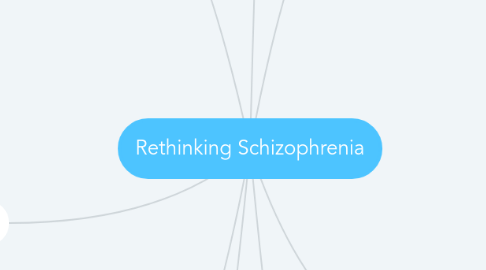
1. Mapping the Pathophysiology of schizophrenia
1.1. A starting point for mapping the pathophysiology of schizophrenia can begin with the increasing recognition that this is a neurodevelopmental disorder, or perhaps more accurately a collection of neurodevelopmental disorders that involve alterations in brain circuits.
1.2. As a final link to development, the genetics of schizophrenia overlaps with the genetics of autism and other neurodevelopmental disorders.
1.3. many of the structural variants associated with schizophrenia implicate neurodevelopmental genes involved with neuronal proliferation, migration, or synapse formation
1.4. Although schizophrenic psychosis usually emerges between ages 18–25, several longitudinal population-based studies indicate that problems are evident much earlier.
1.4.1. Example, a recent report from a 45-year follow up of a Copenhagen birth cohort demonstrated that adults with schizophrenia have a history of delayed maturation including delayed developmental milestones in the first year40.
1.4.2. The emerging picture from genetic studies also indicates that early brain development is affected.
2. Environmental Effects
2.1. Environmental factors identified so far have also implicated prenatal or perinatal events. Maternal malnutrition during famine50,51, infections in the second trimester52, perinatal injury53 and cytokine exposure54 have all been associated with subsequent increased risk for schizophrenia
3. The Stages of Schizophrenia
3.1. Perhaps the most fundamental change from re-conceptualizing schizo- phrenia as a neurodevelopmental disorder is the notion of trajectory of illness.
3.2. Identifying environmental factors, detecting critical epigenomic modifications, or mapping neural circuit differences may render more of the blueprint for risk, much as the algorithms for coronary artery disease use family history, plasma lipids and dietary history.
3.3. To define this earliest stage we will need to define the full architecture of individual risk: genetic and epigenetic biomarkers, cognitive indicators and physiological predictors of vulnerability to the disorder.
3.4. Although standardized clinical assessments will help and longitudinal imaging may yield biomarkers, it is likely that cognitive changes, such as reductions in working memory, may be the best predictor of the psychotic phase of schizophrenia.
4. In the next decade the challenge will be to integrate the impact of genetics, experience and development to identify a complete blueprint of the risk architecture of this syndrome.
5. One-hundred years of schizophrenia
5.1. These early formulations emerging before the split between neurology and psychiatry were consistent with the notion of a mental disorder rooted in brain pathology. ( the study of the mind ignored the brain)
5.2. In the second half of the twentieth century, with the emergence of neuroleptic drugs, the pendulum swung in the other direction—a focus on brain chemistry deemphasized the mind
5.2.1. Schizophrenia was con- sidered a ‘dopamine disorder’ based on the psychosis-inducing effects of dopamine-releasing drugs, such as amphetamine, and the anti-psychotic efficacy of a score of drugs that blocked the dopamine D2 receptor.
5.2.2. yielded medications that trans- formed the treatment of psychosis, allowing patients to be treated outside of hospitals and, in some cases, resulting in remission of the major symptoms of the illness.
5.3. The theory is that schizophrenia, particularly the cognitive symptoms of the dis- order, may result from low activity of the NMDA receptor on GABA inhibitory interneurons in the prefrontal cortex.
6. Schizophrenia is a syndrome: a collection of signs and symptoms of unknown aetiology, predominantly defined by observed signs of psychosis
6.1. presents with paranoid delusions and auditory hallucinations late in adolescence or in early adulthood
7. Schizophrenia in 2030
7.1. Prevention
7.1.1. refocusing our approach to schizophrenia on early detection and early intervention could yield substantial improvements in outcomes over the next decade or two.
7.1.2. Interventions that include an aggressive focus on cognition along with family support may prove surprisingly effective for preempting or forestalling psychosis.
7.2. Reducing the cognitive deficits
7.2.1. Over the next decade, potentially leveraging current research on cognition in Alzheimer’s disease, we can expect a series of pharmacological and nonpharmacological interventions that will reverse or mitigate the cog- nitive deficits of the disorder.
7.2.2. With interventions that reduce cognitive deficits, by 2030 we will be combining somatic, psychosocial and cognitive treat- ments with a goal of curing this disease for many patients.
7.3. Integration of Care
7.3.1. Arguably, doing better with current treatments is our best short-term strategy for enhancing outcomes.
7.3.2. Denial of illness, paranoia, irrational thoughts, deficits in executive function and disruptive behaviour can all be part of the syndrome of untreated schizophrenia, complicating care for those with this disorder. Better treatments, not only better systems, will be necessary for better outcomes.
7.4. Stigma
7.4.1. Our fear of psychosis or disruptive behaviour may keep us from seeing the heroic struggle that people with this disorder face just to survive amidst the internal chaos and panic that is part of this chronic illness.
7.4.1.1. As a vision for 2030, people who suffer from any stage of schizophrenia will be considered to be educable, employable and capable of living in intimate relationships with others.
7.4.2. Some evid- ence indicates that this name change led to reduced stigma, in that fewer people associated the new name with criminality100.
